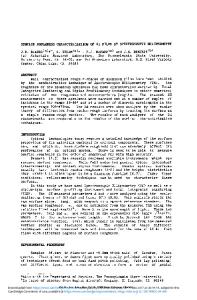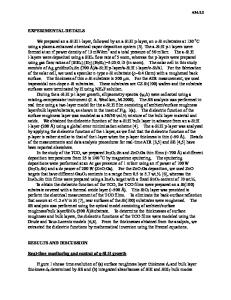Characterization of Ion-Implanted Aluminum and Iron by Spectroscopic Ellipsometry
- PDF / 292,437 Bytes
- 6 Pages / 420.48 x 639 pts Page_size
- 92 Downloads / 385 Views
CHARACTERIZATION OF ION-IMPLANTED ALUMINUM AND IRON BY SPECTROSCOPIC ELLIPSOMETRY J.S. Brodkin*, W. Franzen*, R.J. Culbertson* and J.M. Williams** *U.S. Army Materials Technology Laboratory, Metals Research Branch, SLCMT-EMM-292, Arsenal Street, Watertown, MA 02172 **Oak Ridge National Laboratory, Solid State Division, P.O. Box 2008, Oak Ridge, TN 37831 ABSTRACT The change in the optical constants of aluminum alloy and iron samples caused by implantation with nitrogen and chromium ions has been investigated by spectroscopic ellipsometry. The objective is to develop a method for simple, non-destructive characterization of ion-implanted metals. INTRODUCTION We have studied the effect of nitrogen and chromium implantation on the optical constants of aluminum and iron in order to develop a technique for distinguishing between implanted and unimplanted metals. Reflection ellipsometry is a promising candidate for such a technique since for light in the visible or near-visible range of the spectrum the skin depth in metals is a reasonably good match to the depth of penetration of ions in the 100 key range. The match between these two distances is better for metals of relatively poor conductivity (tungsten and stainless steel, for example) and for implantation with relatively heavy ions (chromium or platinum, for example) than for the opposite case, that is, light ions (nitrogen) and good conductors (copper or aluminum). What matters here is the depth below the surface of the metal to which ion implantation modifies the morphology and stoichiometry of the layers of material under the surface. Amorphization and compound formation as well as the creation of voids would be expected to lead to a change in optical properties, but another important factor influencing these properties is the abrasion of the surface by sputtering during ion implantation. Sputtering not only affects the concentration profile of the implanted atoms but it also has an effect on surface finish: a rough surface may become smoother. Furthermore, surface films (oxide layers) may be sputtered away as well as implanted to some extent. Once implanted, the material may become much more corrosion-resistant than the unimplanted material, thus influencing the rate of formation of a new oxide film after implantation. An implanted metal sample may differ in all these respects from an unimplanted one of the same material. For the development of a practical technique all these effects must be taken into account. EXPERIMENTAL We have carried out a preliminary study of the effect of implantation with chromium and nitrogen ions on the optical
Mat. Res. Soc. Symp. Proc. Vol. 201. '1991 Materials Research Society
290
constants of pure iron (Johnson-Matthey, Ltd.) and an aluminum The technique alloy (no. 2024 which contains about 5% copper). of reflection ellipsometry is illustrated by the diagram of Fig. 1. The ellipsometer was designed and constructed by the Implantation was J.A. Woolam Company of Lincoln, Nebraska [1]. carried out at Oak Ridge National Laboratory.
Data Loading...






